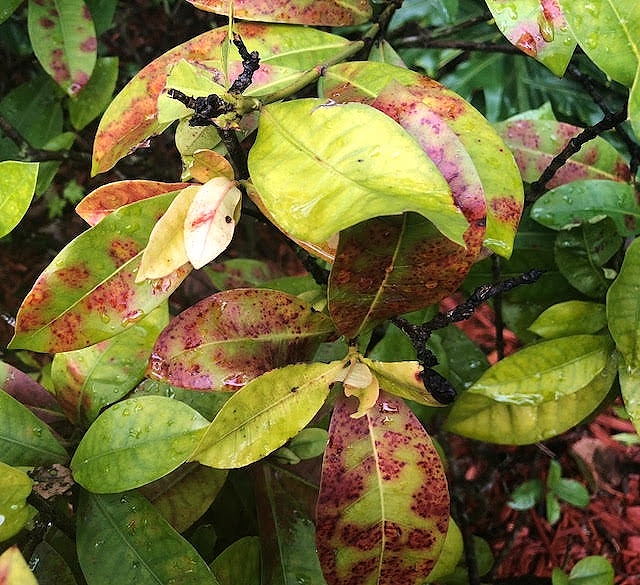
The question came in a text message from a landscape professional; it was a bit of a surprise, but a reminder of a common problem in the South Florida landscape. The manager wanted to know about the Ixora ‘Nora Grant’ in a community somewhat south of the Treasure Coast. She thought a disease was causing the problems and wanted to get a spray program started. Carol, she asked, what can I do to save these Ixora? They are off color, have spots, and have bloomed poorly for a while.
Ixora are not my favorite plants for most Florida landscapes. It is an acid loving plant which means it prefers a soil pH of around 5. Many soils on the Treasure Coast have a pH of 7 or higher, too high for Ixora. High pH soils cause iron and manganese deficiencies, the symptoms of which are yellowing leaves, small new growth, and possibly bud drop.
In the winter, mostly, Ixora leaves can exhibit splotchy red-purple areas on the leaves. Several nutrient deficiencies cause the spots on the leaves, specifically P (phosphorus) & K (potassium). However, there are other factors that contribute to the spotting and decline.
Other players in this syndrome are cool temperatures, which slow the uptake of many nutrients, including P & K, reduced root function from nematode infestation, Ixora is highly susceptible, and aging plants. As to the problem of few blooms, Ixora blooms in cycles, but grow more blooms in warm weather.
Proper fertilization, pruning, and placement can help Ixora survive in the landscape. I recommend a good palm fertilizer such as 8-2-12-4 (the fourth number on any fertilizer bag is magnesium), with chelated micronutrients and 100% slow release N, K and Mg, applied 4 times per year. Fertilization will be a slow and temporary “fix” if the plants are old and over-pruned. Use this fertilizer for the entire landscape, turf, trees and shrubs. The base rate is 12.5 pounds of 8-2-12 per 1000 sq. ft. For deficient Ixora, use the rate of 1.2 to 1.8 pounds of fertilizer per 100 sq. ft. of root zone and a liquid chelated nutrient spray for a quicker response.
Ixora ‘Nora Grant’ is a large maturing plant, easily reaching 12 to 15 feet tall. To encourage more blooming, avoid tight pruning, or at least stop pruning until the weather warms to let the Ixora fuzz out. Ixora blooms occur on new wood, so let it grow in the spring.
As Ixora plants get old, large shrubs pruned short have a life span of 7 to 10 years in the landscape. Eventually, the best treatment for old, spotty Ixora is to replace them with more adapted species.
This column first appeared in the Treasure Coast Newspapers.
Leave a Reply